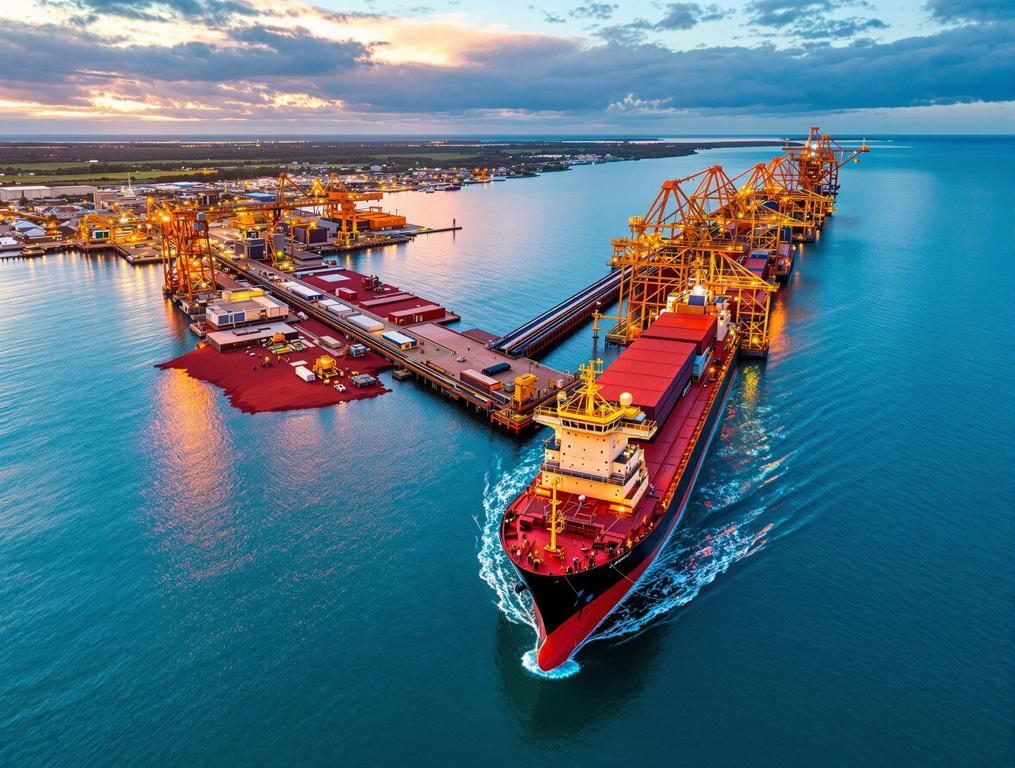The massive iron ore dock looms before me, a steel colossus that stretches nearly a half-mile into Lake Superior’s Agate Bay. I count just four people on the public breakwater beside it. This industrial giant is maintained by a town of just 3,463 residents – fewer people than in my Portland neighborhood farmers market on a busy Sunday. Two Harbors, Minnesota, sitting 24 miles northeast of Duluth, holds an extraordinary secret: one of America’s largest Great Lakes shipping operations hidden in plain sight along Highway 61.
Industrial Goliath, Small-Town Heart: 3,463 Residents and Great Lakes’ Massive Iron Ore Legacy
The contrast is staggering. A community that could fit in a single high-rise apartment building oversees shipping facilities that once anchored the global iron ore trade. Walking along the Sonju Trail toward the working docks, I watch a 1,000-foot freighter – nearly the length of three football fields – being loaded with taconite pellets.
“The scale never fails to impress visitors,” says a dock worker I meet. “Most expect a quiet harbor town, but then they see these ships that could hold the entire town’s population three times over.”
America’s relationship with water transportation spans centuries, from Maryland’s historic ferry town to Two Harbors’ massive ore shipping facilities. But what makes this place truly special is the intimacy of scale – you can watch industrial might at work while standing in a town where everybody knows everybody.
The historic Edna G tugboat, permanently docked nearby, offers a window into the town’s maritime past. Built in 1896, this steam-powered vessel once guided massive freighters safely to dock. Now restored as a floating museum, it sits just steps from the Two Harbors Lighthouse, Minnesota’s oldest operating lighthouse still guiding ships through these waters.
Maritime Mysteries and Two Natural Harbors: Why Geography Made This Town Uniquely Powerful
The town’s name itself reveals its geographical advantage – two natural deep-water harbors (Agate Bay and Burlington Bay) carved into Lake Superior’s North Shore. The Midwest houses several geographic oddities, from North Dakota’s geographic claim to fame to Two Harbors’ rare dual harbor formation.
This unique geography made the location perfect for shipping Minnesota’s iron ore to steel mills across the Great Lakes. Walking the 1-mile breakwater, I watch as a massive ship maneuvers with surprising grace into the loading dock.
“We’ve lived here thirty years, and the romance never fades. When the November gales blow and those ships are still running, you feel connected to a hundred years of Great Lakes maritime history. It gets in your blood.”
The maritime mysteries run deep here. Stories of ghost ships and shipwrecks punctuate local history. While Two Harbors preserves America’s maritime industrial past, those interested in earlier colonial heritage might explore America’s authentic colonial experience in Delaware.
Duluth’s Quieter Cousin: Experience Superior’s Shore Without the Crowds
Two Harbors offers the same relationship to Duluth that Wyoming’s uncrowded alternative does to Yellowstone – an authentic experience without the tourist masses. While Duluth welcomes cruise ships and busloads of tourists, Two Harbors maintains its working-harbor authenticity.
The Black Beach, with its volcanic-derived black sand, rarely hosts more than a dozen visitors at once. Castle Danger Brewery serves craft beers in a setting where locals outnumber tourists – a rarity in Great Lakes summer destinations.
For a town of this size, the concentration of attractions is remarkable. Within 3.27 square miles, you’ll find historic industrial sites, natural wonders, and cultural gems that would typically require exploring a city ten times its size.
Summer 2025: The Perfect Time to Explore Two Harbors’ Maritime Heritage
Summer 2025 offers ideal conditions for exploring America’s hidden water-based destinations, from Connecticut’s hidden waterfall town to Two Harbors’ historic Lake Superior shoreline. With temperatures between 50-70°F, the conditions are perfect for exploring the Lighthouse B&B or hiking the nearby Superior Trail.
Don’t miss the North Shore Commercial Fishing Festival in late July, where the town celebrates its maritime heritage with boat tours, fresh fish, and local music. Morning visits (before 10 AM) offer the best chance to see ore ships being loaded – an industrial ballet that few Americans ever witness.
As I walk back toward town, the afternoon sun catches the red ore dust that coats the dock facilities, giving them a surreal glow against the deep blue of Lake Superior. My daughter Emma would call this “rust and blue magic” – a perfect description of Two Harbors’ unexpected charm.
Like a weathered Great Lakes captain who knows every hidden shoal, Two Harbors navigates the perfect course between industrial might and small-town intimacy. In a country obsessed with superlatives, sometimes the most remarkable places are hiding in plain sight, maintaining the engines of American industry with quiet, unassuming dignity.
